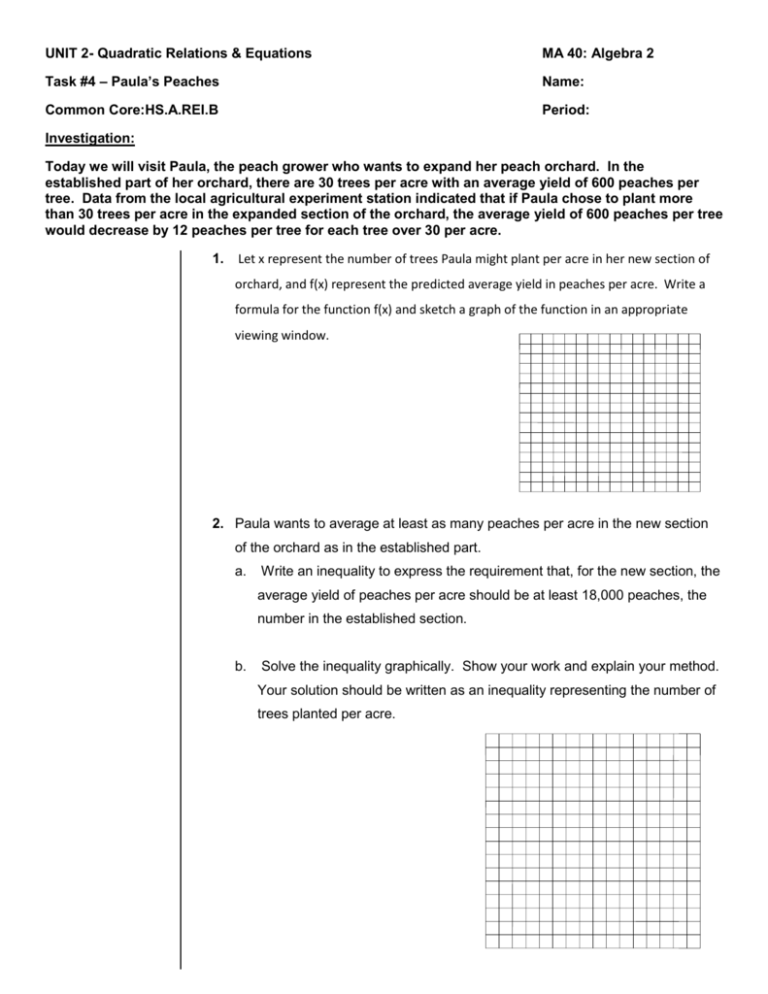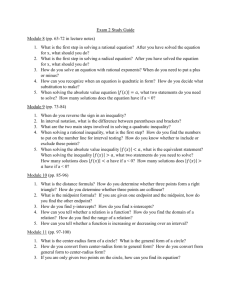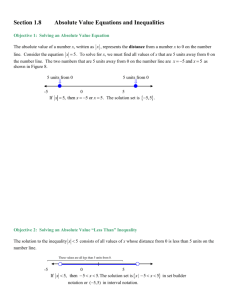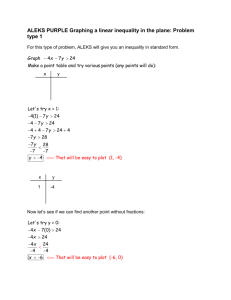UNIT 2- Quadratic Relations & Equations
advertisement

UNIT 2- Quadratic Relations & Equations MA 40: Algebra 2 Task #4 – Paula’s Peaches Name: Common Core:HS.A.REI.B Period: Investigation: Today we will visit Paula, the peach grower who wants to expand her peach orchard. In the established part of her orchard, there are 30 trees per acre with an average yield of 600 peaches per tree. Data from the local agricultural experiment station indicated that if Paula chose to plant more than 30 trees per acre in the expanded section of the orchard, the average yield of 600 peaches per tree would decrease by 12 peaches per tree for each tree over 30 per acre. 1. Let x represent the number of trees Paula might plant per acre in her new section of orchard, and f(x) represent the predicted average yield in peaches per acre. Write a formula for the function f(x) and sketch a graph of the function in an appropriate viewing window. 2. Paula wants to average at least as many peaches per acre in the new section of the orchard as in the established part. a. Write an inequality to express the requirement that, for the new section, the average yield of peaches per acre should be at least 18,000 peaches, the number in the established section. b. Solve the inequality graphically. Show your work and explain your method. Your solution should be written as an inequality representing the number of trees planted per acre. c. Change your inequality in part 2a to an equation, and solve the equation algebraically. How are the solutions to the equation related to the solution of your inequality? d. Plot the solutions of the equation found in part 2c on a number line,. Notice that the solutions divide the number line into three subintervals. Choose one value in each subinterval and “test” it in the inequality. Does the value make the inequality true or false? How does this information help you determine a solution to the inequality? How does this technique relate to your graph in part 2b? 3. Suppose that Paula wants a yield of at least 18,900 peaches. a. Write an inequality to express the requirement of an average yield of at least 18,900 peaches per acre. b. Solve the inequality graphically. Show your graph & explain your work. c. Solve the inequality algebraically by writing a corresponding equation and using the technique from Problem 2. d. Explain how the solution you found in 3c is related to the graph you drew in 3b. Day 2: The equation you solved in part 3c of this task could be written as x2 - 80x + 1575 = 0. Solving by factoring requires that you find factors of 1575. With a number as large as 1575, this could take a long time. Next you will explore an alternative method of solving quadratic equations that applies the vertex form of the equation. The advantages of this method are that it can save time over solving equations by factoring when the right factors are hard to find and that it works with equations involving quadratic polynomials that cannot be factored over the integers. 4. Consider the quadratic function f(x) = x2 - 80x + 1575 a. What are the x-intercepts of the graph? Explain how you know. b. Rewrite the formula for the functions so that the x-intercepts are obvious from the formula. c. There is as third way to express the formula for the function, the vertex form. Rewrite the formula for the function in vertex form. d. Use the vertex form and take a square root to solve for the x-intercepts of the graph. Explain why you should get the same answers as part a. e. Explain the relationship between the vertex and the x-intercepts. 5. Consider the quadratic equation x2 +4x – 3 = 0 a. Show that the quadratic polynomial x2 +4x – 3 cannot be factored over the integers. b. Solve the equation by using the vertex form of the related quadratic function and taking a square root. c. Approximate the solutions to four decimal places and check them in the original equation. d. How are the x-intercepts and axis of symmetry related? Be specific. 6. Suppose Paula wants to grow at least 19,000 peaches. a. Write an inequality for this level of peach production. b. Solve the inequality graphically. Sketch and label your graph. c. Solve the corresponding equation algebraically. Approximate any noninteger solutions to four decimal places. Explain how to use the solutions to the equation to solve the inequality. 7. Suppose Paula wants to grow at least 20,000 peaches a. Write an inequality for this level of peach production. b. What happens when you solve the corresponding equation algebraically? c. Solve the inequality graphically. Sketch and label your graph. d. Explain the connection between part b and c. Summary:__________________________________________________________________________ __________________________________________________________









